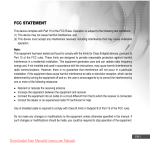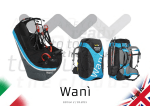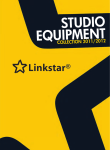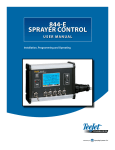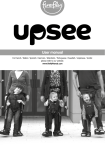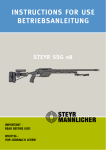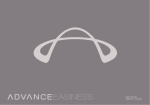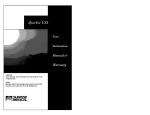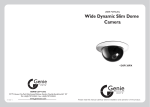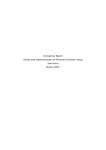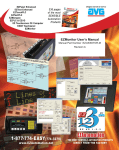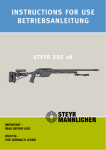Download User manual LIGHTNESS 2
Transcript
User manual Edition 2 / 07_2015 Contents Thank you for flying ADVANCE. . . . . . . . . . . . . . . . . . . . . . . . . . . . . . 6 About ADVANCE. . . . . . . . . . . . . . . . . . . . . . . . . . . . . . . . . . . . . . . . 7 The LIGHTNESS 2. . . . . . . . . . . . . . . . . . . . . . . . . . . . . . . . . . . . . . . 8 Innovations & Features. . . . . . . . . . . . . . . . . . . . . . . . . . . 9 General advice about paragliding . . . . . . . . . . . . . . . . . 10 Handle with Care. . . . . . . . . . . . . . . . . . . . . . . . . . . . . . . . . . . . . . . 11 Preparing the product. . . . . . . . . . . . . . . . . . . . . . . . . . . . . . . . . . . 12 Delivery . . . . . . . . . . . . . . . . . . . . . . . . . . . . . . . . . . . . . 12 Delivery package. . . . . . . . . . . . . . . . . . . . . . . . . . . . . . 12 Setting up the harness. . . . . . . . . . . . . . . . . . . . . . . . . . 13 Large choice of speedbag. . . . . . . . . . . . . . . . . . . . . . . 13 1. Start at the basic settings. . . . . . . . . . . . . . . . . . . . . . 14 2. Set the speedbag length . . . . . . . . . . . . . . . . . . . . . . 16 3. Setting the upper body angle. . . . . . . . . . . . . . . . . . . 17 4. Checking the settings. . . . . . . . . . . . . . . . . . . . . . . . . 17 5. Fine adjustment. . . . . . . . . . . . . . . . . . . . . . . . . . . . . 17 Fitting the speed system . . . . . . . . . . . . . . . . . . . . . . . . 20 Closing the speedbag . . . . . . . . . . . . . . . . . . . . . . . . . . 20 Cockpit and instrument panel . . . . . . . . . . . . . . . . . . . . 20 Stowage compartment . . . . . . . . . . . . . . . . . . . . . . . . . 20 More details. . . . . . . . . . . . . . . . . . . . . . . . . . . . . . . . . . 21 Installing the reserve . . . . . . . . . . . . . . . . . . . . . . . . . . . 22 Use in practice. . . . . . . . . . . . . . . . . . . . . . . . . . . . . . . . . . . . . . . . . 32 Adjusting the rucksack. . . . . . . . . . . . . . . . . . . . . . . . . . 32 Flying in general. . . . . . . . . . . . . . . . . . . . . . . . . . . . . . . 33 Using the speedbag. . . . . . . . . . . . . . . . . . . . . . . . . . . . 33 Using the speed system. . . . . . . . . . . . . . . . . . . . . . . . . 34 Throwing the reserve. . . . . . . . . . . . . . . . . . . . . . . . . . . 34 Walking with the LIGHTNESS . . . . . . . . . . . . . . . . . . . . 35 Packing the rucksack. . . . . . . . . . . . . . . . . . . . . . . . . . . 36 Packing the LIGHTNESS 2 back and under-seat pockets . . . . . . . . . . . . . . . . . . . . . . . . . . . . . . . . . . . . . 37 Using the harness with other brands of paraglider. . . . . . . . . . . . . . . . . . . . . . . . . . . . . . . . . . . . 37 Winching . . . . . . . . . . . . . . . . . . . . . . . . . . . . . . . . . . . . 37 Acro flying . . . . . . . . . . . . . . . . . . . . . . . . . . . . . . . . . . . 37 Tandem flying. . . . . . . . . . . . . . . . . . . . . . . . . . . . . . . . . 37 Replacing parts. . . . . . . . . . . . . . . . . . . . . . . . . . . . . . . 38 Care, repairs and checks. . . . . . . . . . . . . . . . . . . . . . . . . . . . . . . . . 42 Technical details. . . . . . . . . . . . . . . . . . . . . . . . . . . . . . . . . . . . . . . . 45 Technical data . . . . . . . . . . . . . . . . . . . . . . . . . . . . . . . . 45 Materials used. . . . . . . . . . . . . . . . . . . . . . . . . . . . . . . . 46 Edition 1 / 10_2014 3 Service . . . . . . . . . . . . . . . . . . . . . . . . . . . . . . . . . . . . . . . . . . . . . . 47 ADVANCE Service Center . . . . . . . . . . . . . . . . . . . . . . . 47 ADVANCE website. . . . . . . . . . . . . . . . . . . . . . . . . . . . . 47 Warranty . . . . . . . . . . . . . . . . . . . . . . . . . . . . . . . . . . . . 48 Parts LIGHTNESS 2 . . . . . . . . . . . . . . . . . . . . . . . . . . . . . . . . . . . . 50 4 5 Thank you for flying ADVANCE Congratulations and many thanks for choosing a LIGHTNESS 2, an ADVANCE quality product. We hope that it will bring you many rewarding hours in the air. This owner’s handbook is an important component of this flying equipment. In it you will find instructions and important advice about safety, care and maintenance, so we suggest that you read it carefully before your first flight with this product. The latest version of this handbook and updated information can be found on www.advance.ch. Any new safety-related advice about the product will also be published there. If you have a query or problem please go to the retailer, or contact ADVANCE directly. Now we wish you a lot of pleasure with your LIGHTNESS 2 and «happy landings», every time. Team ADVANCE 6 About ADVANCE ADVANCE is one of the worldwide leading paraglider manufacturers, based in Switzerland. Since its founding in 1988 the company has always followed its own ideas and concepts, in both development and production. The results are well-finished products with distinctive character and qualities. Behind the brand is a team of specialists who share a passion for, and confidence in the ADVANCE products they create. At home in the air themselves, they bring valuable personal experience and commitment to the working processes. Comprehensive supervision of the production process and control of working practices at ADVANCE’s own factory in Vietnam guarantees a high quality of workmanship. A many-year relationship with cloth and line manufacturers ensures that ADVANCE knowhow flows directly into the development of new materials. ADVANCE put great value on after-sales customer care, and a worldwide service network has been built up to this end. New knowledge is constantly gained by an on-going exchange of experience with customers, which finds its way into new ADVANCE products – thus completing the «Circle of Service». 7 The LIGHTNESS 2 Well-proven – now perfected. The LIGHTNESS concept created a new category of harness, and now this second generation takes the best of the original and adds to its safety, comfort and style. With a weight from 2.8 kg the LIGHTNESS 2 is a light harness, but, in its current form, it completely satisfies the needs of the ambitious cross country pilot. It has an integrated reserve, certified protector and improved aerodynamics; and again comes with its own rucksack, now including a COMPRESSBAG light. Fully loaded Light Innovations & Features It was possible to save weight when developing the LIGHTNESS 2 by refining the design and choosing the right materials, without compro¬mising the well-known ADVANCE quality. The new COMPRESSBAG LIGHT allows the paraglider to be packed very small in the LIGHTPACK. When put together these make up a light but complete package. §§ LTF certified foam protector Furthermore §§ Tear-resistant 10mm / 15 mm strap system with «easy adjust» buckles High level of handling comfort: §§ Interchangeable speedbag sizes ( like the IMPRESS 3) §§ Two-buckle ADVANCE system for the chest and leg straps ( Safe-T-System ) §§ Closure Remember System 3 products, 1 concept. With its LTF certified foam protector and built-in reserve system the LIGHTNESS 2 is a fully o perational harness for XC and Hike&Fly pilots who like to travel in comfort with light equipment. In the package are the harness and its LIGHTPACK 2, including the COMPRESSBAG LIGHT. Setting up the harness is straightforward and clear. Unlike the original Lightness the LIGHTNESS 2 straps can be adjusted in flight. This makes life much easier and more comfortable for the LIGHTNESS 2 pilot. Comfortable Improved aerodynamics:: §§ Air-filled neck area coordinates an elegant outline LIGHTNESS 2 geometry has been further developed, and the harness now has an ergonomic seat shell which adapts itself to the small of the back. This provides perfect back support; and pressure points become a thing of the past. Feedback from our test pilots: «The most comfortable reclining harness in the history of ADVANCE!» The spoiler on the speedbag guides the airflow up over the upper body, and the (previously empty) zone around the neck is now provided with an inflated cushion, that rounds off the streamlines. An incidental advantage of this inflatable design is that it does not disturb the pilot on the ground / taking off. §§ Clearly defined sitting position for optimal aerodynamics 8 §§ Integrated reserve system with shoulder support points §§ Drink tube openings and holding loops on the shoulder straps §§ Additional stowage space §§ Neoprene covers on the leg straps §§ Speed system with ball bearing pulleys §§ Opening for relief tube 9 Safety advice Like all commercially available reserves paraglider harnesses are not at all suitable for freefall use because of their design features. The reserve parachute and its connections to the harness are not constructed for an abrupt opening. All adjustments to the harness should be carried out before flight. Correct set-up of the harness plays an important part in ensuring satisfactory function, safety and flying comfort. The LIGHTNESS 2 is exclusively to be used for paraglider flying. General advice about paragliding To take part in the sport of paragliding appropriate training and well-founded knowledge of the equipment are needed, as are the necessary insurance and licensing. A pilot has to be able to correctly assess the weather conditions before flight. His abilities must be good enough to manage the demands of the paraglider that is to be used. When carrying out paragliding the pilot must also take responsibility for his care of the natural world and the landscape. Handle with Care Every pilot bears exclusive responsibility for all risk encountered when carrying out paragliding, including resulting injury and/or death. Neither the manufacturer nor the seller of the equipment can guarantee the safety of the pilot or be held responsible for it. ADVANCE LIGHTNESS 2 products are extremely lightly built and intended for specialised use. This puts particularly high demands on their handling and care. A committed interest in the products and their characteristics is essential. Because of the choice of materials and construction rucksack and harness are much more vulnerable to wear and tear from improper use than regular ADVANCE products. Caution: ADVANCE considers it important that you remain aware of the lightweight fabrics in the LIGHTNESS products. You can enjoy the harness and rucksack for a long time – but only if you look after them carefully. The label ‘Handle with Care’ is there to remind you that the lifespan of these products depends very much on your own care and attention. LIGHTNESS 2 products should never be dragged over the ground. All the zips are for light use only; they should never be closed under heavy loading. Pointed and sharp objects do not belong in the harness back compartment, underseat stowage, speedbag side pockets, or the rucksack; they can damage the fabric. When accelerating make sure the feet stay in the centre of the speedbag or centred on the carbon footboard, and do not press into the speedbag floor or sides – where they will cause undesired friction and wear. Other essential items include the wearing of an adequate helmet, suitable shoes and clothing, and the carriage of an emergency parachute (reserve). Equipment must be checked for damage and its airworthiness confirmed before every flight. A pre-takeoff check must always be carried out. 10 11 Preparing the product Delivery Before delivery every ADVANCE product has to be checked by the authorised dealer for completeness of the delivery package and correct basic settings. A fully completed warranty form ensures that deficiencies in the product, attributable to the manufacturer, are covered by the ADVANCE warranty (see ‘Warranty’ in the section “Service”). Delivery package LIGHTNESS 2 delivery includes: §§ Harness and Speedbag with carbon footboard §§ 2 Alias carabiners §§ COMPRESSBAG LIGHT §§ LIGHTPACK 2 §§ Integrated cockpit §§ Detachable mini chest strap §§ EN /LTF foam protector for the seat area §§ Comfort foam for the back 12 §§ Reserve V-connection and reserve handle connected to the four-flap inner container §§ Speed system §§ ’Getting started’ booklet The Kit contains (not fitted): §§ Removable instrument panel Setting up the harness The LIGHTNESS 2 can fit your body shape perfectly. ADVANCE actually recommend the LIGHTNESS 2 basic setting as an efficient and good set-up; it has been arrived at and refined by the ADVANCE test team. It will give the majority of pilots a comfortable and optimum fitting, assuming you have chosen the right harness size. (See ‘Technical Data’) Start out from the basic settings and make your own adjustments step by step according to the instructions that follow. They cover all the important criteria, such as upper body support, pressure distribution, speedbag length and the best speedbag angle for performance. All buckles can be adjusted in flight. The rest of the LIGHTNESS 2 adjustment system can only be set on the ground; ADVANCE therefore recommend that you get well acquainted with the adjustments before your first flight in the harness. In any case, your first test flight should take place in quiet weather conditions. not happen – the foundation for the highest level of comfort on long flights has been laid. Can a LIGHTNESS 2 be combined with a speedbag of a different size? A suitable harness can be found for just about any pilot because the speedbag also comes in the three standard sizes, S, M and L, and is made of stretchy material. In special cases each harness can be combined and ordered with a speedbag of a different size because all three speedbags are interchangeable. If a speedbag is changed for a different size make sure that you use the speedbag lines of the new speedbag! Important: ADVANCE recommend that you try both adjacent sized speedbags if you fall in an in-between, grey-area harness region (165cm–172cm, S or M? & 178cm–183cm, M or L?). A correct speedbag length is essential for your comfort and a smooth and efficient harness shape. Large choice of speedbag A well fitting and adjusted speedbag is the fundamental factor for comfortable LIGHTNESS 2 flying. When this adjustment is correct the harness seat shell fits like a second skin; sliding around does 13 1 2 3 4 5 6 Legstrap Breaststrap Thigh straps Speedbag lines Back straps Shoulder straps Caution: Setting up your LIGHTNESS 2 is not complicated or difficult so long as you follow the recommended step by step procedure. ADVANCE recommend that you try to achieve the ideal position as described. Caution: Small changes to any of the straps have a large effect on the overall setting. Proceed towards your individual fitting in very small steps and always set all straps symmetrically, left and right, so that your glider likes to fly straight. Tip: Pack the back compartment and install the reserve before you start adjusting. This will give something close to a realistic flying attitude. 1. Start at the basic settings To begin with make sure all the straps, including the speedbag lines, are at their basic settings. This is indicated by the base of an end loop level with its corresponding white mark. The harness is delivered in this condition. Note: Speedbag line settings are marked by the mark showing at both sides of the knots. 14 15 2. Set the speedbag length More adjustments: 3. Setting the upper body angle Now you can adjust the speedbag length to suit your leg length. This setting positions your centre of gravity on the harness, and sets the speedbag flying angle. For best aerodynamic results the underside of the speedbag should be horizontal. To set the length first loosen the upper speedbag lines completely, then adjust the lower speedbag lines – which carry most of the leg load – to your perfect speedbag length. Now pull in the upper speedbag lines as far as you need for a comfortable foot angle. The angle of the footboard itself can be adjusted by slightly altering the top to bottom relationship of the speedbag lines. Now you can alter your upper body recline angle using the back straps The back straps are mounted relatively high at the sides. This gives good back support and takes pressure off the shoulders. Finally you can tighten or loosen the shoulder straps as you wish – quite loose, or providing light support – but without putting pressure on the shoulders. A good speedbag length will support the legs lightly on the footboard, without effort or strain. Upper and lower speedbag lines should both be under light tension, and symmetrical ( same left and right ). Important: A well fitting and adjusted speedbag is the basis of comfortable LIGHTNESS 2 flying. When this adjustment is correct the harness seat shell fits like a second skin; there’s no sliding around – the foundation for the highest level of comfort on long flights has been laid. Tip: Foot support is part of the speedbag and this is what supports you in your reclining position. The speedbag is removable, but only for repair or replacement ( see section “Replacing parts“ ). The LIGHTNESS 2 harness only works with its speedbag. Tip: Compared with the original LIGHTNESS the LIGHTNESS 2 calls for noticeably less force on the footboard to keep the legs horizontal. This has been achieved by improved line geometry. 4. Checking the settings Run through the following points to check your perfect position: 5. Fine adjustment Supporting the lower back The lower back strap does the following two things: §§ Improves comfort ( the harness conforms to the small of your back, like a good car seat ) §§ Pushes the body centre of gravity forward if the lower surface of the speedbag is not horizontal, and points uphill. It can help to find the ideal position Upper thigh strap §§ Is the underside of the speedbag still horizontal? If not you can move your centre of gravity by changing the length of the upper and lower speedbag straps. It’s best to get an observer to check the speedbag angle. You can extend the support line of the seat shell under your thighs with the help of the upper thigh straps. Fine adjustment here can increase your comfort. §§ Are the back straps low enough so that they don’t cut into your armpits? Setting the leg straps §§ The front edge of the harness should not be pressing the backs of your knees. Leg straps are not adjustable. §§ The speedbag should not have any obvious wrinkles. Repeat the procedure as often as necessary – after every flight ( if you like ). Perfect is best: it works well. 16 17 Adjusting the chest strap You can alter the carabiner distance by varying the chest strap setting . The ADVANCE development team recommend a ‘good shoulder width’ of about 45 cm as ideal. The possible adjustment range is between 40 und 48 cm, measured between carabiner base centres. The chest strap is closed by Cobra buckles and makes up the Safe-T-System. The wider the chest strap the more agile will be the seat, and weight steering will be more effective. A narrow setting gives q uiet, damped flying characteristics. The adjustable range is large and you can match harness agility to the conditions during flight, as you wish. Important: Always close the chest strap first, then the Closure Remember System, and after that the speedbag. Before every takeoff, especially after an unsuccessful takeoff attempt, check that both buckles are closed by a firm pull on the webbing. If the chest strap is not closed you can fall out of the harness. Caution: Always make sure that all buckles are closed. Tip: The most important thing about chest strap adjustment is that you feel good in the harness. The LIGHTNESS 2 is provided with the Closure Remember System. This is a safety device attached to the chest/leg straps which draws the pilot’s attention to the chest strap when he closes the speedbag before takeoff, thus reminding him that the chest strap should also be closed. This safety device may prevent the pilot who unfastens the chest strap, leaves the speedbag closed (e.g. following a failed takeoff), then takes off again, from falling out of the harness. 18 19 Fitting the speed system Stowage compartment More details Connect the speed system to the glider using Brummel hooks or an anchor hitch. The length of the speed system can be adjusted on the short grey lines inside the speedbag. Move the overhand knots symmetrically. The speed system is correctly adjusted if you can use the glider’s whole accelerate range. Make sure the lines are not adjusted so short that the glider is always accelerated. There is a 6 litre volume compartment for your choice of equipment in the best place under the seat, close to the centre of gravity. Shoulder holders Closing the speedbag To close the speedbag put the left side over the right and the plastic ball through its loop. When the flying position is taken up after takeoff stretching the legs on the footboard automatically closes the speedbag and pulls the cockpit into its flying position. Cockpit and instrument panel The cockpit is part of the speedbag and has a zip-fastened pocket on top. At delivery there is a foam blank in the pocket which supports the cockpit and makes the spoiler shape. You can leave the blank there or use the space for your own things. The instrument panel supplied in the kit goes directly on the cockpit. The panel has room for a GPS and/or vario, as well as several tape loops for securing instruments. The panel itself and the instruments can also be secured by line to loops on the cockpit. 20 LIGHTNESS 2 shoulder straps have a Velcro patch and neoprene loop. These can be used for holding items such as an emergency alarm or Solario vario. Drink system routeing In the back compartment outside the comfort foam is a pocket for a drink system container. The drinking tube can be led out through an opening in the centre of the back compartment and secured by the neoprene loop on a shoulder strap. Pilot relief system routeing There is an opening in the speedbag neoprene, on the right, behind the outer side pocket, for leading a pilot relief tube overboard. Follow the side pocket seam inside the speedbag to find this opening. 21 Installing the reserve General advice Every reserve/harness combination has its own peculiarities. It is essential that pilots and parachute packers familiarise themselves with the system and how it works – especially if any part of it is new (new reserve in existing harness or vice versa ), so that reliable operation can be assured. Suitable reserves Reserve compartment volume Basically, bulky old-style reserves in compact, modern harnesses can be difficult to release, especially under high g loading. The certified volumes for the LIGHTNESS 2 are specified as a function of harness size: size S 3 to 5.5 litres, size M 3 to 6 litres; size L 3 to 6.5 litres. A very rough volume approximation can be obtained from the reserve weight by using this formula ( Reserve weight in Kgs x 2.7 = Volume in Litres ). But, depending on packing quality and style, it could still be possible that a reserve does not release faultlessly, even though it conforms to the approved maximum volume – if c alculated by this formula. 22 In the end analysis a compatibility test will decide in every case whether a particular reserve/harness combination works properly. Caution: A reserve parachute volume can expand by up to 30% when it has been newly folded. ADVANCE therefore strongly recommend that a new compatibility test is carried out after every repack. Steerable reserves A steerable reserve can be connected directly to the two coloured support points under the shoulder strap covers, using two similar Maillons Rapide of 2400 daN safe working load. The parachute risers run into the reserve compartment in the channel provided. The normal harness V-connection (not used) can be led into the back compartment through the existing opening, then stowed away in the comfort foam pocket. Once again a compatibility test will decide if the chosen reserve works properly with the LIGHTNESS 2. Caution: Steerable reserves tend to take up more volume. Info: You can also use Quick-Out carabiners with a steerable reserve on the LIGHTNESS 2. Packing a reserve in the LIGHTNESS 2 The LIGHTNESS 2 reserve compartment is in the best aerodynamic position near the pilot’s centre of gravity. The harness/reserve connection runs in a channel at the side of the harness, closed by a zip fastener. The reserve compartment is closed by a closure flap; the reserve system is thereby well protected from the outside, and accidental releases are hardly possible. A well-designed release system guarantees reliable and fast opening. Caution: Installing a reserve should be done by a qualified person. Inner container and its fixed reserve handle The reserve handle and the four-flap inner container are permanently connected together, and are designed so that the pull of the handle is directed evenly over the width of the container. This minimises the risk of the container turning and jamming in the compartment, or becoming caught up in the reserve lines, and guarantees a perfect reserve throw. The reserve handle and the four-flap container are a part of the harness, and meet the latest LTF certification requirements. Only the original reserve handle and its fourflap inner container may be used. 23 Packing the reserve in the inner container Connecting harness V-connection and reserve bridle Pack your reserve to match the shape and size of the official inner container; for the LIGHTNESS 2 this means that the reserve has to be packed in a long and narrow shape. Put the reserve lines on the opposite side to that of the reserve handle. Connect the harness V-connection and the reserve bridle using a Maillon of at least 2400 daN safe working load. Stabilise V-connection and bridle on the Maillon using rubber O-rings: this is to prevent them slipping round and side-loading the Maillon when the reserve is thrown. To make this connection by direct looping should only be done by the harness manufacturer or a trained and qualified person. If the loops are not positioned correctly there is a risk that slipping, heating by friction and failure may occur when the reserve opens. Caution: Do not use sticky tape or cable ties ( instead of O-rings) to stabilise the Maillon connections. 24 25 Putting the inner container into the reserve compartment Spot to spot First lay the V-connection and reserve bridle in the reserve compartment, then the inner container. It is essential that the inner container is installed with the closure flaps facing downwards. The reserve handle connection must not be twisted. When correctly installed spot faces spot. Caution: If the reserve has already been packed but does not fit the shape of the inner container it must be folded again to match the inner container. Closing the reserve compartment First lead the lower, longer yellow cable (1) though the buttonhole in the neoprene pocket ( 2 ) then through the channel on the underside of the harness to the outside. Then lead the shorter yellow cable ( A ) to the side, through the red marking ( B ) and out of the neoprene pocket. Tip: If this V-connection channel zip gets pulled open, the whole zip fastener must be reset by opening it completely and closing it again. Now fit the reserve handle into its neoprene pocket. Put its connecting strap into the gap provided for it. Then secure the loop (3) through the eyelet (4) with the lower ( longer ) cable and guide its end into the red bordered channel provided for it. Open the zip fastener on the side (C ) all the way to its start, then close it completely. Caution: use Feeling - not strength! Stow the zip puller in its garage. Protect the start end of the zip with the upper ( short ) cable, by pulling this through the loop ( D ) and stowing it in the buttonhole. 26 27 28 29 Doing a compatibility test In every case correct stowage of a reserve must be checked by means of a test release. To do this you must be sitting in the harness while it is hanging up by its carabiners, with the back compartment packed as for flight. It is not good enough to pull out the reserve or release the handle if you are not sitting in the harness. For a successful test you must be able to release the reserve while in the flying position, in accordance with the guidelines in this manual, without problem. Make sure that the release force is not less than 4 daN and not more than 7 daN. If you are not sure about this do not hesitate to contact a qualified person or your ADVANCE dealer. §§ The reserve is not thrown using the correct technique. A sideways throwing motion is required (Caution: don’t pull it upwards). §§ The reserve volume was OK when fitted into a new harness, but now it’s too big after a repack. §§ The pilot’s arm length can be a factor for successful reserve throwing. Small people with short arms might sometimes not be able to release a reserve. §§ When throwing is attempted under high g-loading ( > 3G, e.g. in a spiral ). Info: Successful compatibility tests carried out by pilots romotes confidence in their emergency systems. p The reserve must release as a result of the correct throwing action – for the LIGHTNESS 2 a pull to the side. If this is not the case throwing your reserve could be a problem. Caution: Before every flight check that the reserve h andle is in the correct position, and that the yellow cables are c orrectly routed. The following factors can make reserve throwing difficult or prevent it, especially if they apply together: Tip: We recommend that, during every flight, you briefly put a hand on the reserve handle – so as to remind yourself where it is. We advise that you mentally rehearse the sideways throwing action. §§ The reserve is too big or too bulky for the compartment or inner container. §§ The reserve has not been packed to the lengthwise shape of the inner container. 30 31 Use in practice Adjusting the rucksack 2. Adjust the shoulder straps Flying in general Using the speedbag The LIGHTPACK 2 Rucksack has been designed specially for the LIGHTNESS 2 harness. The two sizes, S/M and L, are arranged to carry a normal size paraglider, the LIGHTNESS 2 harness and speedbag, reserve, helmet and the most important items of clothing. The compactness and geometry of the system provides a high degree of carrying comfort. Pull in the shoulder straps so that you can feel tham, but not so that they put pressure on the shoulders. The low mounting of the shoulder straps adapts to different upper body lengths. When correctly adjusted the shoulder straps lie over the shoulders, but do not press or load them. The LIGHTNESS 2 is flown in a reclining position. If you have adjusted the harness correctly information from the wing will be transmitted directly to your nether regions. Your weight will be evenly distributed from the thighs to the shoulder blades. This means that pressure points will be avoided, circulation will continue unimpeded, and you will maintain your concentration on long flights. The aerodynamically optimised speedbag protects you from the cold while serving as a foot support. Do the following takeoff checks before every takeoff: After lift off keep the forward-leaning upper body position so that you do not slide down in the harness: you can then easily pick up the dangling speedbag with a foot – preferably the right one. A quick look down at the speedbag opening makes this easier to do. The speedbag closes automatically when you stretch your legs in it, and pressure on the footboard pushes you back into a comfortable reclining position. Side pockets provide space for small objects and for a drink system. The two lower side pockets are easy to reach while walking. Never close the light duty zip fasteners under tension. For an ideal individual adjustment ADVANCE recommend that you proceed as follows for a fully packed rucksack: 1. Adjust the waist strap The fastened waist strap of a packed rucksack should lie on the hip bones. Pull the waist strap in at this position as far as feels good. A correctly adjusted waist strap should carry most of the rucksack weight on the hips. 32 There’s room for clothes and instruments in the LIGHTPACK 2. Side stowages, pockets at the back and in the waist strap, as well as the multi-purpose bungee on the cover provide space for additional things. When the rucksack is full the side pockets can each carry a 1.5L plastic bottle. The two lower side pockets are easy to reach while walking. Hiking poles can be carried in the fastening loops on the outside of the rucksack. Caution: never drag the LIGHTPACK 2 over the ground. Never pack pointed or sharp objects in the rucksack, or in any of the pockets. They can damage the fabricc. 1. Helmet and harness chest strap fastened, reserve ok 2. Lines free 3. Canopy open 4. Wind direction and strength checked 5. Airspace and view free Caution: Always fasten the chest strap first, then the speedbag. Before every takeoff, and especially after a failed takeoff, check – by a physical pull with the hand – that you have closed both quick release buckles correctly. If the chest strap is not closed you can fall out of the harness. After taking up the flying position and stretching your legs the speedbag closure system will automatically close the speedbag top and bring the cockpit into position. For landing take both feet out of the speedbag in good time, and take up an upright position. Always make a stand up landing, so as to avoid damage to body or equipment. Tip: The speedbag can be very warm; if it gets too warm inside bend a knee to let air in. 33 Using the speed system Walking with the LIGHTNESS The speed loop is tensioned forward so you can always easily reach it. One leg should always be straight to keep tension in the speedbag. When you wish to use the second speed loop step, the foot already on the first speed step automatically takes over this function. Accelerating with one foot means you can feel the wing better and use the speed system for active flying. While pushing the speed loop be careful not to push your heels into the speedbag floor in your enthusiasm to burn rubber. This could overstress the speedbag material. (See also “Fitting the speed system” in the section ”Using the harness“.) This is most comfortable when the rucksack is full and under light ‘full up’ tension. The volume of the rucksack is partly taken up by a correctly folded glider, then fine tuning follows automatically with the expansion of the harness protector foam, which takes up the available space. The rucksack does not need a compression strap. Caution: Always connect your speed system to the wing. Free-hanging speed lines could interfere with a reserve throwing. Throwing the reserve In an emergency pull the reserve handle out with a firm tug and throw it (and the inner container) into free airspace. The lines will straighten, which opens the inner container. The reserve canopy will extend and fill. Disable the paraglider by pulling down strongly on the B or C risers, so that it does not compete with the reserve and encourage scissoring. This happens when both canopies pull against each other on opposite sides of the vertical flight path. 34 Pack hiking poles – points upward – in the harness back compartment, not too full of course, and without creating extra tension. An overstuffed back pocket can affect inflation during flight. Tip: ADVANCE recommend that you always have rubber tips available for your walking poles. These not only protect others’ ears from the annoying clacking on the road, but p rotect the rucksack when all are stowed in the back of the harness in flight. Tip: To save space don’t carry drinks in plastic bottles or food in plastic containers, but in zip bags or in bar form. When empty the bags take up little space. Drink systems ( like a camelbak ) can be stowed in the rucksack side pocket and the tube secured in a shoulder strap loop. 35 Packing the rucksack Fold the paraglider to the width of the rucksack and pack it in its COMPRESSBAG LIGHT in the rucksack first, on the back padding, and push it to the bottom. Fold the harness in half with the carabiners inside. Lie the harness – with the comfort foam on top - on the glider and slide it completely down in the rucksack. Compress the package so that you can fold the rucksack cover down and easily close the zip fasteners. Finally stand the rucksack up. Clothing can be pushed behind the harness and the remaining space on top filled with h elmet, instruments and supplies. Caution: Never drag LIGHTNESS 2 products over the ground. Close all the zip fasteners gently and never under tension. Never pack pointed or sharp objects in the harness back pocket, the under-seat pocket or inside the rucksack: they can damage the fabric. 36 Packing the LIGHTNESS 2 back and under-seat pockets Using the harness with other brands of paraglider ADVANCE give you a compression bag with the LIGHTNESS 2 so that the paraglider takes up minimum space in the rucksack. The COMPRESSBAG LIGHT is ideal for the LIGHTNESS 2. The LIGHTNESS 2 can be used with any glider - there is no restriction. The COMPRESSBAG LIGHT is delivered in 2 sizes; however you cannot choose your own size. The S/M COMPRESSBAG LIGHT goes with the 82Ltr LIGHTPACK 2, and size L the 90Ltr LIGHTPACK 2. Careful packing of the 2 harness stowages has a significant effect on flying comfort. Oddly shaped and hard objects can be felt through the back and lower seat shell surface and can affect your reclining comfort. First pack the COMPRESSBAG LIGHT in the harness back compartment and push it all the way down. Roll up the LIGHTPACK 2 long and thin, and push that into the back pocket. The remaining space should be used sensibly. Pack hiking poles (rubbered points upwards), rations and clothes cautiously around the rolled rucksack, but do not pack too full, or strain the back compartment. Winching All ADVANCE harnesses are suitable for winching. Connect your LIGHTNESS 2 to the tow link using rope loops or Maillons from the main carabiners. If in doubt always consult the winch driver, or someone authorised by the manufacturer. Acro flying The LIGHTNESS 2 is not suitable for acro flying. Freestyle manoeuvres pose no problem, however. Tandem flying The LIGHTNESS 2’s size and purpose mean that it is not at all suitable for tandem flying – whether for a pilot or passenger. 37 Replacing parts Speedbag Speed loop The LIGHTNESS 2 harness is delivered with a foam protector u nder the seat, comfort foam in the back and a fitted speedbag, footboard and speed lines. These parts can be removed for replacement or repair. To fit a new speedbag first take the carabiners out of the red loops. Then open both zips, the Velcro strip, and disconnect the speed lines. The blue lower footboard (speedbag ) lines, that go from the seat shell front and back up through the pulleys must also be undone ( at the speedbag and seat shell! ). To fit a new speed loop start at the grey connecting loop on the end. This attaches to the bungee coming from the footboard inside the speedbag. Now lead the grey speed lines through the first pulleys, (1) then through the red markings ( 2 ). Pull them through the second pulleys, and out of the harness through the openings in the sides of the speedbag (3 ), where they can be connected to the wing by Brummel hooks or anchor hitches. The length of the speed lines can now be adjusted at the grey interconnect lines inside the speed bag. Move the overhand knots the same amount each side. Foam protector and comfort foam The foam protector compartment is under the seat, between the reserve and the ballast stowage. Open the zip fastener, and take out the foam protector. The comfort foam is in its own compartment in the back pocket. Open the zip fastener, and take out the comfort foam. Now you can remove the old speedbag and fit the new one by refitting the speed lines, the blue lines (to the seat shell ), then the Velcro and the two zips. Caution: Always use the official blue lines that come with the new speedbag.. Caution: Hang all the red loops in the carabiners, otherwise the speedbag zips will be irreparably damaged when loaded. Info: The footboard is a part of the speedbag, and provides an essential support for the reclining position. The LIGHTNESS 2 harness only works with the speedbag. Caution: Check that the speed lines do not cross and rub against the lower speedbag lines. Caution: Only use the original speed lines and loop. Other lines, or a speedbar, could chafe and damage the speedbag and harness. Footboard A new footboard should be pushed into the footboard pocket in the speedbag, and the pocket secured with the Velcro. 38 39 40 41 Care, repairs and checks Weight saving was a priority when it came to the choice of materials. The harness was designed for high loadings, but not for extreme physical punishment. The lifespan depends very much on the care of the user. We recommend that signs of wear or damaged seams and webbing are always investigated and, where necessary, individual components of the harness be replaced. In particular, suspected defects should be taken to an authorised service centre for rectification, without delay. Caution: Do not modify your harness, and never fly with a harness whose straps and webbing parts are damaged in any way. It is recommended that a harness has a complete inspection regularly. This must include a check of the condition of seams and webbings as well as of the functioning of closure buckles. This recommendation also includes the regular airing and repacking of the reserve. If the reserve has been thrown in an emergency, the harness should be inspected by the manufacturer or an authorised service centre. Ultraviolet light, temperatures below -20°C and above +60°C, dampness, seawater, aggressive cleaning agents, improper storage and mechanical stress (dragging on the ground) accelerate the ageing process. 42 The lifespan of your harness can be significantly prolonged if the following points are observed: §§ Allow a wet or damp harness to dry in the shade at room temperature. Always repack the reserve. §§ A harness in contact with seawater should be thoroughly rinsed with fresh water. Always repack the reserve. §§ Only clean a harness with fresh water, and neutral soap if necessary – never with solvents. §§ Inspect the connection lines between harness and reserve after every airborne reserve opening. §§ Have the harness inspected by a qualified person after any high loading (e.g. heavy crash landing or failed takeoff). §§ Regularly check the harness for defective seams and webbing. Above all check the reserve V-connection and the seams at the carabiner supports. §§ Do not expose the harness to large temperature changes, and make sure it gets enough air circulation to prevent condensation. §§ Do not leave the harness in the sun (UV light) for longer than necessary. To ensure reliable and fast opening most reserve manufacturers recommend a reserve inspection and repack every 6 months. If the reserve gets wet, damp or very hot it must be repacked without delay. We emphatically recommend that a trained and qualified person be allowed to repack your reserve. In addition ADVANCE strongly recommend that you regularly check the reserve handle yellow cables in their bootlace loops. Make sure they slide easily. Foam protector The foam protector does not need special attention, but should definitely be checked for damage after a crash. If the outer cover is damaged the protector must be replaced. Check All your equipment must undergo a check every 24 months. With intensive use (> 150 flying hours/month) an annual check is required. A check involves a visual assessment of fabric, straps and connections, the most important sewing and the main carabiners. All parts will be inspected for tears, kinks, damaged seams, general damage and evidence of serious abuse. Finally the overall condition of the harness will be assessed and recorded on the service record in the owners handbook. More information about the check can be found under «Service» in the handbook, or at www.advance.ch. Repairs Fundamentally you may not carry out harness repairs yourself. Sewing of the various seams has been done with utmost precision. Only the manufacturer or an authorised service centre may carry out repairs, using original materials. Disposal Protection of the environment is an important feature in the choice of materials and the production of an ADVANCE product. We use exclusively non-hazardous materials and compounds that have undergone long-term quality and environmental impact assessments. When your harness has eventually come to the end of its useful life please remove all the metal parts and dispose of the rest of it at a suitable waste incineration plant. 43 Technical details Technical data LIGHTNESS 2 S M L Pilot height cm 155-172 165-183 178-200 Seat width cm N /A * N /A * N /A * Carabiner height cm N /A * N /A * N /A * Chest strap width cm 40-48 40-48 40-48 Total harness weight including comfort foam and 2 alu carabiners kg 2.8 2.95 3.05 Load test EN 1651 /LTF 91/09, 120 kg Foam protector certification LTF 91/09 LIGHTPACK 2 l 82 82 82 *The seat shell adapts itself to the pilot’s shape so the seat width and carabiner height vary accordingly. 44 45 Service Materials used We routinely check and test the many raw materials available to us. Like all ADVANCE products the LIGHTNESS 2 has been created and manufactured using the latest knowledge and techniques. Outer fabric Ripstop Nylon 70D, PU3 Seat surface fabric Nylon Oxford 210D PU3 / Ripstop Nylon 70D Seat surface base Cordura 210 Speedbag Neopren 1.5 mm Straps Polyster 25 mm 800 kg Chest strap closure system Austrialpin alu Cobra buckles Reserve connection Dyneema 10 46 We have chosen the materials used very carefully, taking into ccount the strictest quality demands. a Certification The LIGHTNESS 2 was tested and certified in accordance with DIN EN-Norm 1651 at 120 kg supported weight. The airbag has LTF certification. ADVANCE Service Center ADVANCE runs two company-owned service centres which carry out checks and repairs of any kind. These centres based in Switzerland and France are official DHV approved maintenance operations soundly based on many years experience and comprehensive product-specific expertise. The worldwide ADVANCE service network comprises further authorised service centres which provide the same level of service. All workshops use exclusively ADVANCE original materials. All the information about checks and repairs and relevant addresses can be found on www.advance.ch. §§ download the check application form as a PDF prior to sending your equipment in to ADVANCE. §§ find an answer to a smouldering question from the FAQs (frequently asked questions ). §§ sign up for the ADVANCE Newsletter, and get regular emails about new developments and products. It’s worth making a regular visit to the ADVANCE homepage because the range of services is constantly developed. ADVANCE website On www.advance.ch you can find detailed information about ADVANCE and their products as well as helpful addresses who you can contact for queries. Among other things, on the website you can §§ complete the online warranty card up to 10 days after purchase, and enjoy the comprehensive advantages of the ADVANCE warranty. §§ find out new, safety-relevant knowledge about ADVANCE products. 47 Warranty To benefit from the comprehensive ADVANCE warranty please fill in the appropriate form within 10 days of purchase. This form is available on the website under «Warranty». As part of the ADVANCE warranty we undertake to rectify any defects in our products that are attributable to manufacturing faults. To make a claim on the warranty you must notify ADVANCE immediately on discovering the defect, and send the defective product in for inspection. The manufacturer will then decide how a possible manufacturing fault is to be rectified (repair, replacement of parts, or of the product ). This warranty is valid for 3 years from the date of purchase of the product. The ADVANCE warranty does not cover any other claim. In particular it does not cover damage caused by careless or incorrect use of a product ( e.g. inadequate maintenance, unsuitable storage, overloading, exposure to extreme temperatures etc.). The same applies to damage attributable to an accident or normal wear and tear. 48 49 Parts LIGHTNESS 2 50 1 2 3 4 5 6 7 8 9 10 11 12 Mainstrap Shoulderstrap Backstrap Lower Backstrap Frontstrap Breaststrap Legstrap Breast Buckle Adjustment buckle Adjustment buckle V-Line emergency Speedbag lines 51 advance thun ag u t t i g e n g s t r a s s e 87 ch 3600 thun f o n + 41 3 3 225 70 10 f a x + 41 3 3 225 70 11 w w w. a d v a n c e.c h i n f o @ a d v a n c e.c h
































